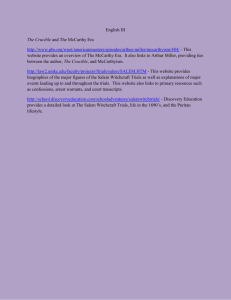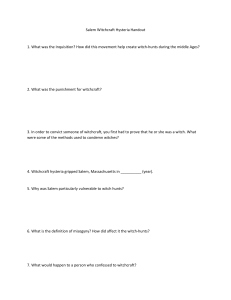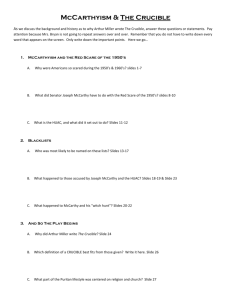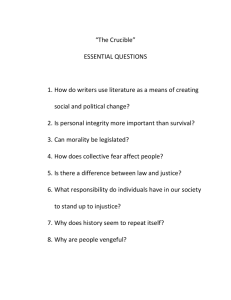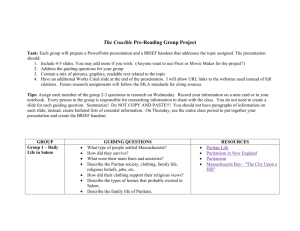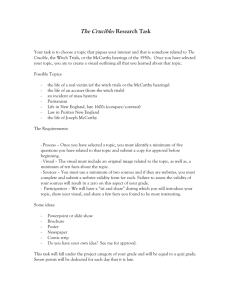The Crucible
advertisement
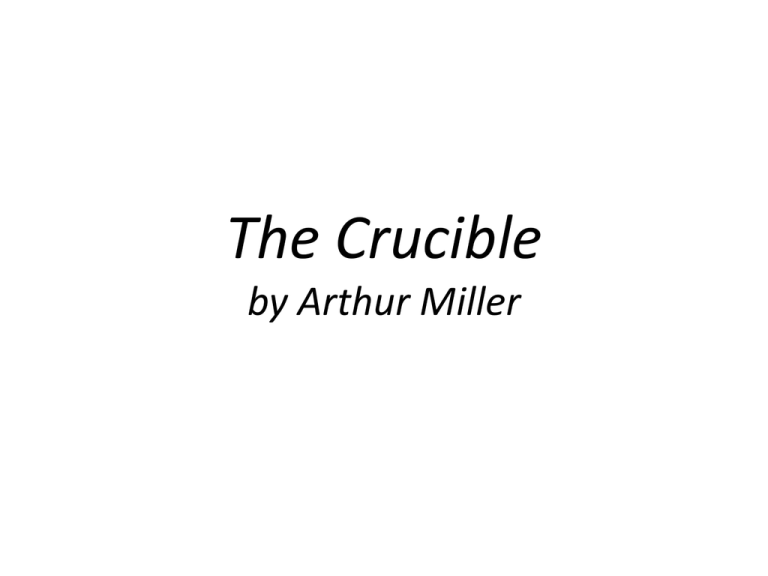
The Crucible by Arthur Miller Bio • Born October 17, 1915 • Middle-class upbringing in Jewish faith • Studied as little as possible – school was an interruption • Great Depression – needed an education Bio • Did not go to college until 19 – University of Michigan – wanted to write • Playwright • All My Sons; Death of a Salesman • 1953 – The Crucible >>> lukewarm reviews • 1958 – successful revival Crucible • Earthenware pot or bowl used for melting • Whatever is in a crucible is subject to intense heat • Metaphysical – a severe, even, agonizing test McCarthy Era • Senator Joseph McCarthy (R, WI) • House Un-American Activities Committee, 1953 • Communist hunt • America in danger from a Communist conspiracy to take over the world • “witch hunt” • Black listed – ended careers Salem Witch Trials v McCarthyism • Climate of fear • Wholesale suspension of rational judgment • People who challenged the authority of the court found themselves under suspicion of guilt • “Notion that conscience was no longer a private matter but one of state administration • People’s questions of authority found themselves under suspicion • Disregard for legal rights: no counsel, guilty by association Causes for the Outbreak of Witchcraft Hysteria in Salem • Strong belief that Satan is acting in the world “The invisible world”: disease, natural catastrophes, and bad fortune attributed to work of the devil • Belief that Satan recruits witches and wizards to work for him. Prior witchcraft cases in N.E. and Europe • Belief that a person afflicted by witchcraft exhibits certain symptoms Cotton Mather’s Memorable Providences Most symptoms can be feigned • Time of troubles, making it seem likely that Satan was active Smallpox Congregations strife in Salem Village Frontier wars with Indians • Stimulation of imaginations by Tituba – charismatic • Convulsion ergotism, disease caused by eating infecting rye (ergot) that can produce hallucinations, causing strange behavior (interesting theory – but likely?) • Teenage boredom No forms of entertainment (CD, TV, etc) – lots of Bible reading Strict and humorless Parris household (as well as Puritan households) • Magistrates and judges receptive to accusations of witchcraft Seen as way to shift blame for their own wartimes failures Admission of “Spectral” evidence – spectral means spirit • Confessing “witches” adding credibility to earlier charges • Old feuds (disputes within congregation, property disputes) between the accusers and the accused spurring charges of witchcraft Why the Hysteria Ended • Doubts grow when respected citizens are convicted and executed Rebecca Nurse (jury first acquits, then told to reconsider) George Burroughs (recites Lord’s Prayer perfectly at hanging) Giles Corey (81 year-old is pressed to death) • Accusations of witchcraft include the powerful and wellconnected Wife of Governor Phips Mary and Philip English (and others) • The educated elite of Boston pressure Gov. Phips to exclude “spectral” evidence Rev. Samuel Willard and others Increase Mather points out the Devil could take the shape of an innocent person: “It were better that 10 suspected witches should escape than one innocent person should be condemned.” • Gov. Phips bars spectral evidence and disbands the Court of Oyer and Terminer Lessons Learned from Salem? • Hysteria happens • Children (especially) can be influenced by suggestion and peer pressure to say things that are not true. • We should be skeptical of confessions when the confessions are the result of torture or when the person has a self-interest in confession. • A cooling off period can sometimes prevent injustices Lessons • Trials should be fair Evidence introduced should be reliable Witnesses should be subject to crossexamination Defendants should have legal assistance and be allowed to testify on their own behalf Judges should be unbiased Modern-day witch hunts? • HUAC/McCarthy “Communist hunts of early 1950s (events that inspired The Crucible) • Day care abuse trials of 1980s (child witnesses, accusations multiply, people afraid to support accused, unbelievable charges, hysteria) • McMartin Preschool Abuse Trial (longest and most expensive criminal trial in American history) The Crucible – Literary Terms • • • • Style 3 ½ months time frame 1 week between acts Action in 4 places – all around Salem • • • • POV John Proctor – victim Feel his suffering Good, honest but not perfect • Allegory – expended metaphor>>>persons and objects in story represent meaning outside of the story Surface>>>>Salem Witch Trials Allegorical>>>>McCarthy Era • Exposition – part of the play which is not presented dramatically Direct statements Set stage “Greek Chorus” • Antecedent Actions – action that occurs before the play opens (i.e. dance in the woods) • Symbolism – something that stands for or represents something else • Conventional – widely known or accepted (universal) • love, heart • no, not • Personal – developed on a personal level • Symbols Candlesticks, title to house, firewood – Parris’ materialism Dancing – pleasure (forbidden) Strength – John Proctor’s resolve Voice of reason – Rebecca Nurse Evil - ???????????????? Self-sacrifice – Giles Corey Abuse of authority – Judge Danforth What is “right” – Rev. Hale Form and Structure • 21 characters • Act I – sets up terrible possibility • Act IV – brings terrible thing to pass >>>>>>>>>>>>>>>>>>>>>>>>>>>>>>>>>>>>>>>>> • Act I – Will town leap to witchcraft? • Act II – Will the Proctors get caught up in the witch hunt? • Act III Will Abigail foil John’s attempt to discredit her? • Act IV – Will John Proctor hang? Themes • Individual conscience and guilt by association • Individual commitment to the society in which one belongs • No man can live his own personal life, ignoring the events around him • Hypocrisy • Revenge Themes • • • • Abuse of authority Guilt Hysteria Integrity and courage Theme Statements • It is possible for human beings who appear to be agreeable and normal to be knowingly fully committed to evil. • A mounting tide of evil within a society can gain ascendancy disproportionate to the evil in any one member. • Truth has no meaning when men believe only what they want to believe. • Honest common sense is impotent against unyielding fanaticism. Theme Statements • Men can insulate themselves from truth and rationality by a chauvinistic confidence in their own judgment. • The infection of evil may spread by ordinary people who are both the mindless agents and victims. Theme Statements • Long-suffering may instruct that moral integrity, human dignity, and spiritual freedom are of more value than a life without them. • All evil needs to succeed is for good men to stand by and do nothing.
